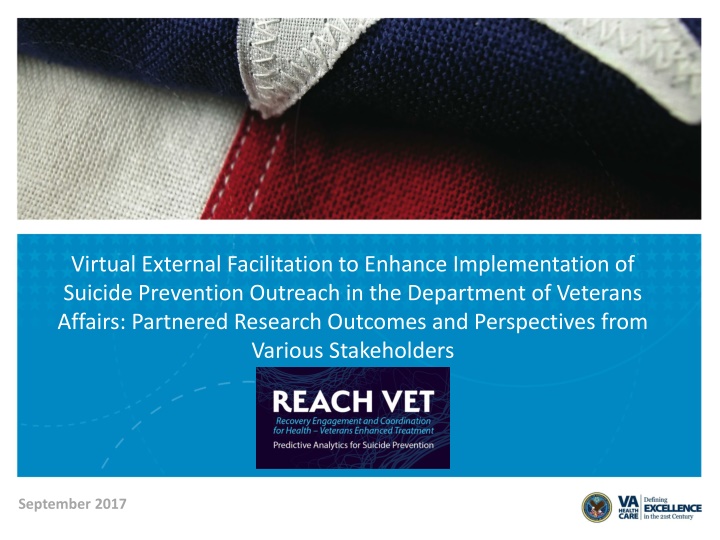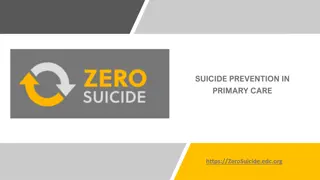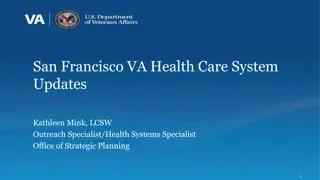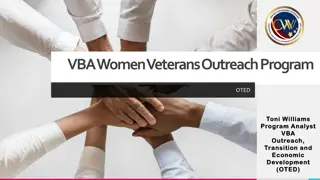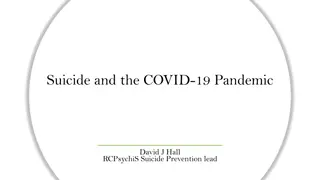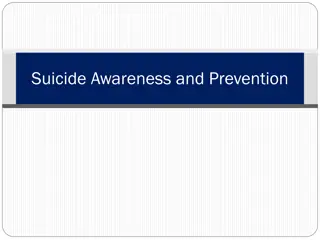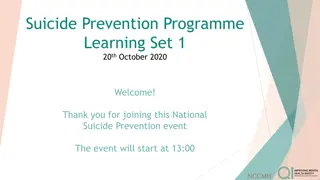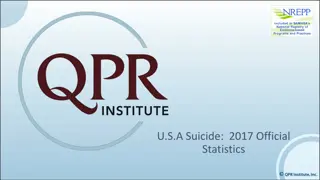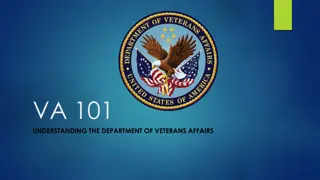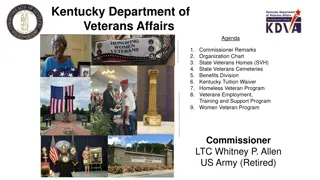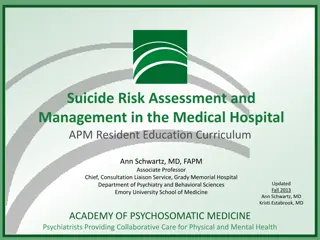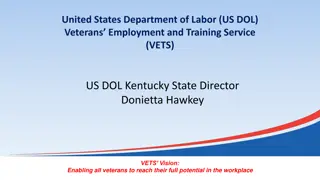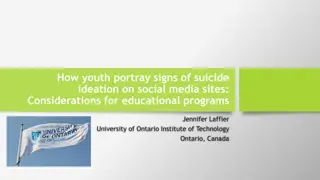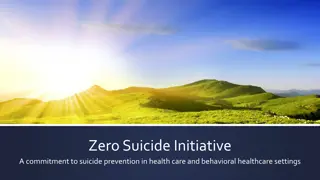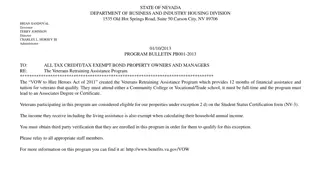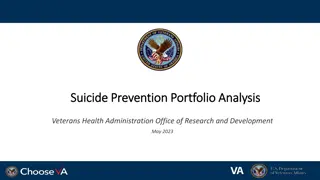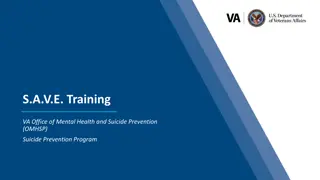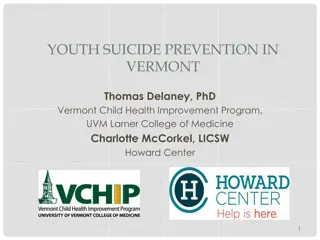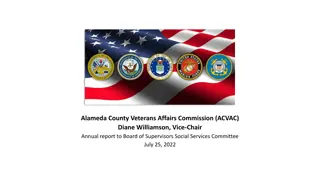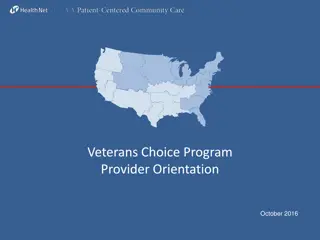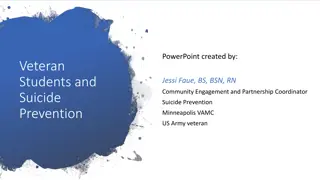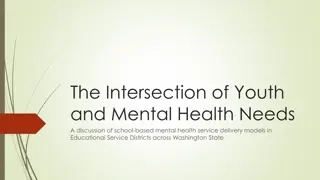Enhancing Suicide Prevention Outreach in Veterans Affairs
This presentation discusses the implementation of suicide prevention outreach programs in the Department of Veterans Affairs, focusing on research outcomes, stakeholder perspectives, and the use of predictive models to identify at-risk veterans.
Download Presentation

Please find below an Image/Link to download the presentation.
The content on the website is provided AS IS for your information and personal use only. It may not be sold, licensed, or shared on other websites without obtaining consent from the author.If you encounter any issues during the download, it is possible that the publisher has removed the file from their server.
You are allowed to download the files provided on this website for personal or commercial use, subject to the condition that they are used lawfully. All files are the property of their respective owners.
The content on the website is provided AS IS for your information and personal use only. It may not be sold, licensed, or shared on other websites without obtaining consent from the author.
E N D
Presentation Transcript
Virtual External Facilitation to Enhance Implementation of Suicide Prevention Outreach in the Department of Veterans Affairs: Partnered Research Outcomes and Perspectives from Various Stakeholders September 2017
National Implementation of a Suicide Prevention Outreach Program in the Department of Veterans Affairs: Perspectives from an Operational Partner Aaron Eagan September 2017
This presentation is based on work supported by the Department of Veterans Affairs, but does not necessarily represent the views of the Department of Veterans Affairs or the United States Government. The REACH VET program is funded by the Department of Veterans Affairs Office of Mental Health and Suicide Prevention. VETERANS HEALTH ADMINISTRATION 2
Based on the finding that although suicide rates in VHA patients have decreased relative to the US adult population as a whole, they remain high Supported by senior VA leadership as part of establishing suicide prevention as a major priority Goes beyond intercepting people on the trajectory towards suicide Uses predictive models to identify Veterans whose care should be enhanced Supplements current clinical strategies to identify at-risk Veterans Complements other VHA initiatives designed to identify new opportunities to enhance care for Veterans VETERANS HEALTH ADMINISTRATION 3
Developed by VA and NIMH researchers Includes clinical and administrative data for each Veteran who utilizes VHA health care services Calculated Risk Outcome Top .1% Top Risk Suicide (one month) 33 x Suicide (one year) 15 x Suicide attempt (one year) 81 x *As compared to overall VHA population VETERANS HEALTH ADMINISTRATION 4
Top .1% Top Risk 8.8x 1.5x 66.0x 6.3x Outcome Other external-cause mortality Other all-cause mortality Mental health inpatient bed days of care Medical/Surgical/Rehab inpatient bed days of care VETERANS HEALTH ADMINISTRATION 5
Demographics (e.g., age >= 80, male, married) Prior suicide attempts Diagnoses (e.g., depression, diabetes, homelessness) VHA service utilization (e.g., emergency dept visit, psychiatric discharge) Medications (e.g., antipsychotics, opioids, statins) Interactions (e.g., anxiety disorder x personality disorder, widowed x male) McCarthy et al., 2015 VETERANS HEALTH ADMINISTRATION 6
Enhanced Care VETERANS HEALTH ADMINISTRATION 7
REACH VETCoordinators MH and Primary Care Providers 1. 2. 3. Access the dashboard Identify appropriate provider Communicate with identified provider Document in EMR 1. Receive notification about a high risk Veteran 2. Re-evaluate care 3. Consider treatment enhancement strategies 4. Outreach the Veteran 5. Document in EMR 4. VETERANS HEALTH ADMINISTRATION 8
Strategies ERIC Implementation Strategies Creation of dashboard to provide names Facilitate relay of clinical data to providers Policy memos Mandate change Identification of a coordinator at every VA medical center Identify and prepare champions Web-based training Conduct educational meetings, conduct ongoing training Creation of educational and support materials Develop educational materials, distribute educational materials Reports to VISN leadership on progress Audit and provide feedback Technical assistance Centralize technical assistance Powell et al., 2015 VETERANS HEALTH ADMINISTRATION 10
National leadership priorities Changes to implementation plan (e.g., rolling out to facilities gradually) Changes in resources available VETERANS HEALTH ADMINISTRATION 11
Worked with clinical team and evaluation team to determine how to provide additional assistance to facilities needing help to fully implement REACH VET Identified facilitation as an implementation strategy used in VA to implement other changes, such as Primary Care-Mental Health Integration Attended facilitation training with clinical team, which included facilitators, and evaluation team Collaborated with experts in facilitation to determine plan for facilitation VETERANS HEALTH ADMINISTRATION 12
Aaron Eagan, RN, MPH Office of Mental Health and Suicide Prevention REACH VET Program Manager Aaron.Eagan@va.gov VETERANS HEALTH ADMINISTRATION 14
Virtual External Facilitation to Support Implementation of a Suicide Prevention Outreach Program in the Department of Veterans Affairs: Facilitation Activities and a Facilitator's Experience Kaily Cannizzaro September 2017
This presentation is based on work supported by the Department of Veterans Affairs, but does not necessarily represent the views of the Department of Veterans Affairs or the United States Government. The REACH VET program is funded by the Department of Veterans Affairs Office of Mental Health and Suicide Prevention. VETERANS HEALTH ADMINISTRATION 16
Facilitation A process of interactive problem solving and support that occurs in a context of a recognized need for improvement and a supportive interpersonal relationship Facilitation can be internal or external to a system. This interactive support process can include a combination of any implementation strategies, and typically bundles multiple strategies as needed Powell et al., 2015 VETERANS HEALTH ADMINISTRATION 17
ERIC Implementation Strategies Assess for readiness and identify barriers and facilitators Audit and provide feedback Purposefully reexamine implementation Develop and implement tools for quality monitoring Develop a formal blueprint Conduct a local needs assessment Facilitation Technical assistance Tailor strategies Promote adaptability Use data experts Tailor strategies Organize clinician implementation team meetings Conduct local consensus discussions Use advisory boards and workgroups Involve executive boards Conduct ongoing training Conduct educational meetings Create a learning collaborative FACILITATION TOOLBOX VETERANS HEALTH ADMINISTRATION 18
External Facilitator Facilitators Kaily Cannizzaro Georgia Gerard Molly Jankovsky Clinical experts in suicide prevention Trained in facilitation 2 day training with VA experts in facilitation Included a virtual component Site champions REACH VET Coordinator Site Champion VETERANS HEALTH ADMINISTRATION 19
Year 4 Year 2 (FY19) Year 3 (FY20) Year 1 (FY18) Fiscal Year FY17 2017 2018 2019 2020 Year (calendar) 9 10 11 12 1 2 3 4 5 6 7 8 9 10 11 12 1 2 3 4 5 6 7 8 9 10 11 12 1 2 3 4 5 6 7 8 9 10 11 12 1 2 3 4 5 6 7 8 9 10 11 12 13 14 15 16 17 18 19 20 21 22 23 24 25 26 27 28 29 30 31 32 33 34 35 36 37 38 39 40 Month (calendar) Study Month Site 1 Aug. 29th Site 2 Aug. 30th VISN A Site 3 Aug 31st Site 4 Sept. 19 Site X Sept. 20 Site 5 Site 6 VISN B Site 7 Site 8 Site 9 Site 10 VISN C ` Site 11 Site 12 Site 13 Site 14 VISN D Site 15 Site 16 Site 17 Site 18 VISN E ` Site 19 Site 20 Site 21 Site 22 VISN F Site 23 Site 24 Site 25 Site 26 VISN G Site 27 Site 28 VETERANS HEALTH ADMINISTRATION 21
REACH VET Program Manager offered implementation support to VISNs VISN Directors and Mental Health Leads determined if they wanted facilitation Facilitation and evaluation team reviewed data from the REACH VET dashboard to determine which VISNs appeared to need the most assistance Focused on one coordinator task and one provider task Identified the VISNs that would benefit most from facilitation Identified sites within the VISN that would benefit most Worked with evaluation team to determine order of VISNs receiving facilitation Reviewing sites within each VISN three months before facilitation starts VETERANS HEALTH ADMINISTRATION 22
The facilitators are also part of the clinical team for REACH VET Have helped created and lead Online trainings for coordinators and providers Videos to demonstrate actions needed in REACH VET Provide technical assistance via REACH VET helpdesk email Created a facilitation toolbox customized to REACH VET VETERANS HEALTH ADMINISTRATION 23
Kaily Cannizzaro, PsyD Rocky Mountain MIRECC for Suicide Prevention REACH VET Clinical Team kaily.cannizzaro@va.gov VETERANS HEALTH ADMINISTRATION 25
Randomized Program Evaluation of National Implementation of a Suicide Prevention Outreach Program in the Department of Veterans Affairs: Initial Outcomes and Experiences in Partnered Research Sara J. Landes September 2017
This presentation is based on work supported by the Department of Veterans Affairs, but does not necessarily represent the views of the Department of Veterans Affairs or the United States Government. The REACH VET program is funded by the Department of Veterans Affairs Office of Mental Health and Suicide Prevention. The REACH VET randomized program evaluation is funded by the Department of Veterans Affairs Health Services Research and Development (HSR&D) Service (Landes, SDR 16-195). VETERANS HEALTH ADMINISTRATION 27
VA Health Services Research and Development (HSR&D) Service published a new announcement for Learning Healthcare Initiative Randomized Program Evaluation Purpose: to conduct randomized program evaluations of the impacts of new programs or policies that are planned for wide-spread implementation within VA The request for applications was to support evaluation for a select set of topics recently solicited from VHA operational and program leaders Clinical implementation of the program or policy is the responsibility of the health care system and relevant program office Approved concept papers received 6 months of planning funds to develop a full proposal in collaboration with their operational partner VETERANS HEALTH ADMINISTRATION 28
Given that the grant was funded to evaluate a program being implemented, the evaluation design had to change to accommodate changes in the program The design started as a stepped wedge Changed to a crossover design And has since returned to a stepped wedge The program and evaluation have been impacted by Changes in national VA leadership Changes in funding Changes in the clinical intervention Changes in timeline Changes in targeted facilities As the evaluation team, we are documenting these changes to demonstrate how they may have impacted implementation VETERANS HEALTH ADMINISTRATION 29
Initially facilities were going to be randomized to when they started implementing REACH VET Leadership determined that all facilities needed to implement as soon as possible Facilities were then going to be randomized to when they would receive implementation support (facilitation) Revised in the facilitation training; facilitation will now occur in one VISN at a time Combining site visits into one trip to reduce burden on facilitators and travel budget Working with sites that have similar regional contexts and leadership Given the resources, 7 VISNs will receive facilitation Randomization not appropriate PEPReC assigned start times based on mean mental health domain quality standardized scores, which capture facility variation in population coverage, continuity of care, and experience of care VETERANS HEALTH ADMINISTRATION 30
Effectiveness evaluation led by John McCarthy and the Serious Mental Illness Treatment Resource and Evaluation Center (SMITREC), a national VA program evaluation center Does REACH VET decrease Veteran suicide? What other patient-level impacts are there from REACH VET? Implementation evaluation led by Sara Landes and the evaluation team funded by HSR&D Focused on the implementation outcomes of REACH VET and the effect of the implementation strategies used Comparing implementation as usual (IAU) vs. IAU + facilitation VETERANS HEALTH ADMINISTRATION 31
Reach: the proportion of patients identified at each facility who receive the REACH VET intervention Adoption: proportion of facilities that implement REACH VET and the proportion of mental health and primary care providers in each facility that participate Implementation fidelity: whether facilities implemented all components of the intervention as directed by the memos and the REACH VET program website Cost of implementation: document the amount of effort and time needed to offer virtual external facilitation Cost of the intervention: document the amount of effort and time needed to implement REACH VET activities Organizational context: Organizational Readiness for Change survey Barriers, facilitators, experience of facilitation process: done via qualitative interviews VETERANS HEALTH ADMINISTRATION 32
Using the same methods as other Behavioral Health QUERI projects using facilitation to allow comparison across projects Time and activity tracking logs (Bauer et al., 2017) Facilitator debrief interviews Includes a Key Events Template (Woodward et al., 2016) VETERANS HEALTH ADMINISTRATION 34
Example of activity definition 1. Assessment/Evaluation of implementation or outcomes activities include: Working with facilities or REACH VET Coordinators to identify current practice patterns for REACH VET implementation, for the purposes of reducing adverse outcomes, including suicide in Veterans. Conducting audit and feedback using REACH VET dashboard data. Conducting interviews to gather information about strengths, barriers, and creative solutions utilized in overcoming these barriers . Assessing organizational context/environment, including needs, barriers, and key stakeholders in REACH VET implementation (e.g., resources, data capture systems, culture, leadership, etc.). VETERANS HEALTH ADMINISTRATION 35
Questions vary based on pre-implementation (before and after sites identified) and implementation/post-implementation All include the Key Events Template VETERANS HEALTH ADMINISTRATION 36
What sites are you currently working with? [For new sites] What do you know about those sites so far (e.g., leadership, barriers, facilitators)? What is the status of REACH VET implementation at those sites? What kinds of activities have you been doing during the last week? Have you had any special meetings or site visits during the last week? If yes, please give me a blow by blow account. What was the process for the visit? Who attended meetings? What were the barriers and facilitators you identified? What did you do as a facilitator at the meeting? What follow-up plans do you have? Has anything significant happened in regards to REACH VET in the last week? Dashboard changes Policy changes Other program changes Have any of the events from the key event menu happened (if site specific, note which site)? [For the interviewer, if already mentioned, just note, such as facilitator activities.] VETERANS HEALTH ADMINISTRATION 37
Personnel Changes Staff Added/Lost (any relevant personnel that are not in formal leadership; e.g., clerks, providers, quality assurance manager) Leadership Turnover (lost/added) Facilitator Activities Implementation Planning Event (e.g., kickoff event, site visit) General Education About an Intervention (e.g., educating a general group of stakeholders) Mentoring of Providers on the Intervention (e.g., specific coaching and supervision of clinicians implementing the intervention) Data Gathering and Feedback (audit & feedback in any form) VETERANS HEALTH ADMINISTRATION 38
Clinic Events Leaders Communicating with Staff (when leaders communicate or share messages, either formally or informally, with their staff about the intervention or events/initiatives that might affect the implementation of the intervention) Physical Space Changes (e.g., providers move locations, televideo equipment is secured and installed) Referral Process Changes (e.g., a new flow of how patients get from point A to B is initiated; formal or informal) Broader Context Events Regional Events (e.g., VISN telehealth initiative rolls out) Organizational Events (e.g., new VA secretary; it is possible that the regional and organizational events may be lumped together for certain healthcare systems. For VA, they remain separate.) External Events (Events external to the organization; e.g., political changes, impactful current events) VETERANS HEALTH ADMINISTRATION 39
~ 6 months in after full implementation Identifying ~6,700 Veterans per month Identified more than 20,000 unique Veterans to date Launched CPRS template that substantially decreases administrative burden Started external facilitation with first VISN VETERANS HEALTH ADMINISTRATION 40
Practice or policy implications for stakeholders Using feedback from the field during implementation can result in an improved intervention For example, the REACH VET dashboard has been revised based on user feedback for an improved experience Generalizable practice or policy implications Partnered research where the operational partner and evaluation team work together from the beginning allows for co-creation of a design that both addresses the practical needs of operational or clinical stakeholders and allows for the design of the most rigorous evaluation possible given those needs This may be an example of work that is closer to what Kitson and colleagues (2017) call for in their description of a KT Complexity Network VETERANS HEALTH ADMINISTRATION 42
Sara J. Landes, PhD South Central MIRECC, Central Arkansas Veterans Healthcare System REACH VET Evaluation Lead sara.landes@va.gov VETERANS HEALTH ADMINISTRATION 43
Discussant JoAnn Kirchner September 2017
PI I KC E KS VETERANS HEALTH ADMINISTRATION 45
Extra Slides with Quotes if Needed for Audience Questions VETERANS HEALTH ADMINISTRATION
So far I only have one Veteran on the REACH VET program. I educated him about how Veterans are selected for the designation... I then educated about how this would impact his treatment by pointing out he was already engaged as we would want him to be. Veteran expressed gratitude for the increased awareness of suicidality as well as for the CAMS group, which he finds very helpful. I think it s a relief for him to know we are all aware of his risks seems to have increased his accountability! - Lexington, KY VETERANS HEALTH ADMINISTRATION 47
I explained REACH VET by informing [the] Veteran he had been identified as being at higher risk due to diagnosis and inpatient VA utilization. Veteran responded by stating he felt he could benefit from mental health counseling to assist with depression and anxiety issues. - Lexington, KY VETERANS HEALTH ADMINISTRATION 48
Yesterday, I nudged a provider to try one more time. He [the Veteran] was just discharged from a non-VA BH facility; he AGAIN told her no .but about an hour later he called back and scheduled an appointment! - Alexandria, LA VETERANS HEALTH ADMINISTRATION 49
